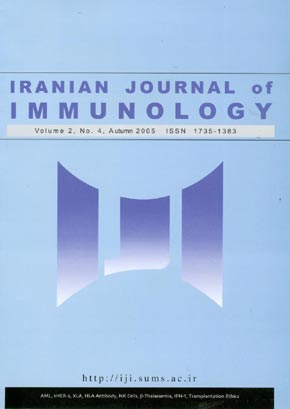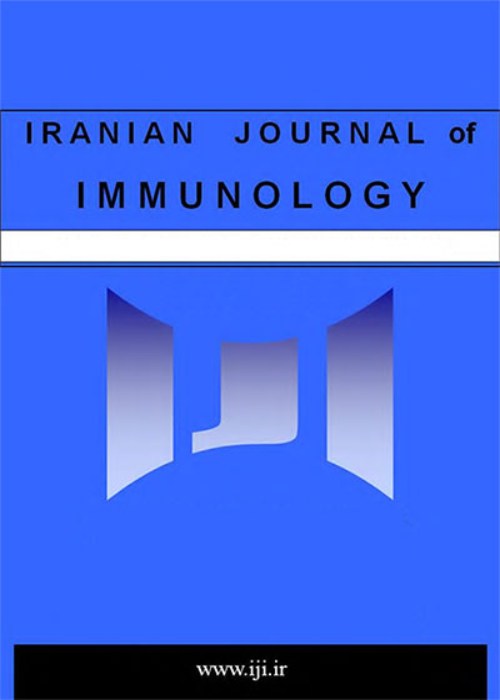فهرست مطالب

Iranian journal of immunology
Volume:2 Issue: 4, Autumn 2005
- 64 صفحه،
- تاریخ انتشار: 1384/10/10
- تعداد عناوین: 8
-
-
Pages 191-200BackgroundA soluble form of HER-2/neu extracellular domain (sHER-2) is reportedto be released in the sera of metastatic breast cancer patients.ObjectiveTo measure the level of sHER-2 in sera of 115 breast cancer patients.MethodsSerial samples of 27 patients with metastasis, 18 non-metastatic patients, 15 patients in stage 0/I and 14 patients with accompanying benign breast disease were also included in this study.ResultsNo significant difference was observed between sHER- 2 level in the pre-operative sera of breast cancer patients and that of healthy individuals. Only 8 out of 27 patients whom later developed metastasis showed elevated levels of sHER-2 in their first serum sample. However, a trend of increase in the level of sHER-2 was observed in 14 (51.8%) of 27 metastatic sera before clinical diagnosis of the metastasis. A significant association between sHER-2 positive status and vascular invasion of the tumor was observed (P = 0.02). In addition, significant correlation of sHER-2 level with CEA (highest r = 0.74) and CA 15.3 (highest r = 0.74) tumor marker levels in the serial sera were observed. The mean time from sHER-2 positivity to tumor metastasis was calculated to be 98 days (range = 29-174).ConclusionOur results indicate that a relatively high percentage of Iranian patients with breast cancer show an elevated level of sHER-2 in their sera before clinical diagnosis of the tumor metastasis. Therefore, measuring the level of this oncoprotein, not only helps physicians in monitoring the patients during HERCEPTINTM therapy, but also can be helpful in choosing more aggressive treatments at the early satges of tumor metastasis.
-
Pages 201-207BackgroundThe B-cell defect in X-linked agammaglobulinemia (XLA) is causedby mutations in the gene for Bruton''s tyrosine kinase (BTK). BTK mutations result in deficient expression of BTK protein in peripheral blood monocytes.MethodsUsing the anti-BTK monoclonal antibody (48-2H), a flow cytometric analysis of intra cytoplasmic BTK protein expression in monocytes was performed to identify Iranian patients with XLA phenotype. To examine the possible identification of XLA patients and female carriers by this assay, we studied 13 XLA families.ResultsThe flow cytometric assay showed deficient expression of the BTK protein in 12 (92%) families. One patient exhibited a normal level of BTK expression. The cellular mosaicism of BTK expression in monocytes from obligate carriers was clearly shown in 9 of 12 (75%) families.ConclusionThe results suggested that most XLA patients have deficient expression of the BTK protein; therefore we conclude that deficient expression of BTK protein can be evaluated by a flow cytometric assay.
-
Pages 208-212BackgroundErythropoietin (EPO) was first known as a factor for red blood cellproliferation and differentiation. New studies show the effects of EPO on immune system.ObjectiveIn this study, the effects of pretreatment with recombinant human erythropoietin (rHuEPO) on the anti-human leukocyte antibody (anti-HLA) titer were determined.MethodsThree groups of rats were sensitized with human lymphocytes. Two of the groups were given 20 or 100 IU/Kg rHuEPO after two sensitizations with human lymphocytes. Control group did not receive rHuEPO. Microlymphocytotoxicity method was used to detect anti-HLA antibodies.ResultsTreatment with rHuEPO caused a significant decline in anti-HLA antibody titer compared to control group. Also, pretreatment with rHuEPO suppressed antibody response after repeated antigenic stimulation.ConclusionSuch results could be due to the effects of rHuEPO on the number or the activity of the B and the T cells. Moreover, the dose of rHuEPO and the length of treatment might affect anti-HLA antibody titer.
-
Pages 213-220BackgroundHuman peripheral blood NK cells constitutively express CD56 andCD16 antigens. Peripheral blood NK cells seem to be strongly related with decidual NK cells, and may reflect the decidual NK cell functional status. There are varied reports concerning the relationship between NK cell cytotoxicity in women with recurrent spontaneous abortion.ObjectiveTo study NK activity in women with history of RSA by using a non-radioactive cytotoxicity assay.MethodsPeripheral blood lymphocytes from RSA and healthy multiparous women were obtained. Lymphocytes were isolated and mixed with K562 NK-sensitive cell line. A nonradioactive method for NK cell cytotoxicity assessment was utilized. Dead K562 cell populations were detected by FACS calibour flow cytometry, and the data obtained was analysed on cell-Quest software. The proportion of CD16+/CD56+ cells was then calculated.ResultsThe proportion of NK cells were 9.21% ± 3.06 and 13.48% ± 4.09 in healthy women and RSA, respectively. The percentage of cytotoxicity was determined to be 19.3% ± 3.9 in healthy group and 27.1% ± 6.5 in RSA group with an effector:target ratio of 50:1. The data shows an increase in PBLs potential for in vitro cytotoxicity assay in RSA individuals. The analyses indicate that there is a weak positive correlation between NK cytotoxicity potential and the percentage of NK cells in PBL population.ConclusionThe present study demonstrates that the percentage of CD56+/CD16+ cells increases in individuals with recurrent spontaneous abortion. We conclude that NK cytotoxicity as well as NK number is partially involved in RSA.
-
Pages 220-226BackgroundBeta-thalassemia major is one of the major health problems in our countryMany studies have confirmed the fact that, these patients have an increased susceptibility to bacterial infections.ObjectiveIn this study, we have assessed the humoral immune system in 68 thalassemic patients by measuring their serum concentration of Immunoglobulin G (IgG), IgM, IgA, C3 and C4 in order to find out a responsible immune defect.MethodsSixty eight b-thalassemia major patients were enrolled randomly from referrals to Dastgheib clinic of thalassemia. The same number of case controls with matched age and sex were selected from healthy people without any history of recent or recurrent infections. Serum IgG, IgM, IgA, C3 and C4 levels were assessed using Single Radial Immunodiffusion (SRID).ResultsSerum levels of IgG, IgM & IgA were significantly higher (P<0.01) and those of C3 and C4 were significantly lower (P<0.01) in thalassemic patients than the controls. Considering the result of analytic tests, it was revealed that, thalassemia patients show much more increase in serum immunoglobulin levels as they get older. Splenectomized patients had higher serum IgG and IgA levels than non-splenectomized patients but had no difference in serum IgM, C3 and C4. Serum ferritin level had no correlation with the changes of humoral immunity; however, patients with serum ferritin level >2500ng/ml had higher serum IgM level.ConclusionThese results can be due to continuous exposure to antigens, repeated infections, chronic liver disease and splenectomy but not iron overload. The only probable cause of humoral immune deficiency found in these patients is a defect in serum complement levels.
-
Pages 226-232BackgroundBrucella is a gram-negative bacterium, causing acute and chronicinfection in humans and animals. Cell-mediated immunity is the main protective immune response against Brucella spp. Activation of macrophages by IFN-γ and generation of reactive oxygen intermediates and nitric oxide are the main immunologic mechanisms responsible for control of Brucella infection.ObjectiveTo investigate the correlation between IFN-γ gene polymorphism and brucellosis.Methods195 patients with brucellosis, 186 healthy patients'' family members and 82 healthy farmers who kept infected animals and consumed their contaminated dairy products were selected to take part in the study. IFN-γ genotyping at position +874 (T→A) was carried out by allele specific polymerase chain reaction (AS-PCR) method.ResultsThe frequency of AT and TT genotypes significantly increased in farmers compared to patients with brucellosis (P=0.03) while there was no significant difference in genotype distribution between patients and their healthy family members.ConclusionIFN-γ (+874) AA genotype is probably a genetic factor that contributes to the susceptibility of the individuals to brucellosis.
-
Pages 232-241Tissue and cell transplantation are regarded as a popular procedure in clinical sciences, prospecting a new horizon for several incurable diseases. Along with its usefulness, many ethical concerns accompany this development. The ethical issue of organ transplant is unique to the source used which includes: living related, living unrelated, cadaveric, and xenotransplant. Obtaining organs has a separate set of ethical concerns which are discussed under two headings, namely salvage and donation. Then there is the issue of organ marketing and the ethical, social, and economical issues it encompasses. All these are active areas of debate, and we have touched upon them by turn. This century has brought a new aspect of transplantation into the light, stem cell transplantation. Here we present some work done recently on mesenchymal stem cells and their outcome. These cells are now being employed in the therapy of some incurable ailments. It seems this kind of transplantation, although possessing its own range of issues, could prove to be the way of the future.


